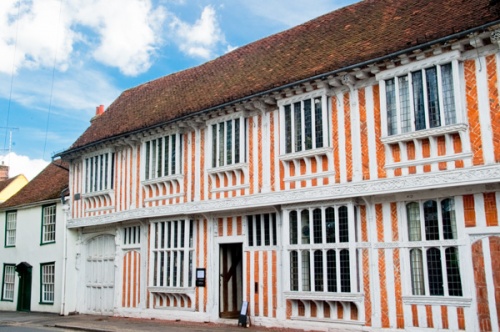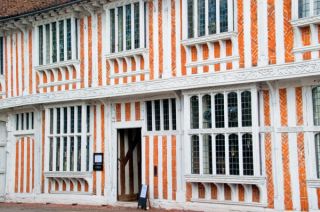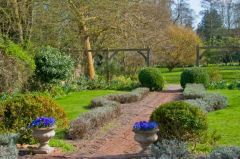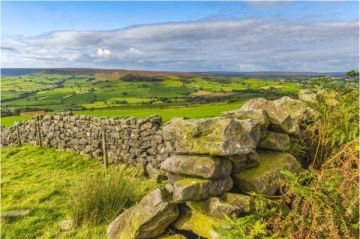
Paycockes has been called one of the most attractive timber-framed houses in England. I'd say that's just about spot on! This lovely half-timbered merchant's house dates to the early 16th century, adapting an existing medieval hall.
The house was altered around 1600 and again in the 18th century. It was built by Thomas Paycocke for his new bride, Margaret Harrold, and the initials of both bridge and groom are carved in several places on the exterior and interior of the house. Margaret died before the couple could have any children and Thomas remarried, but the original initials stayed in place.
The Paycocke Ermine
You can also carvings of the ermine tail emblem adopted by the Paycockes as their symbol. This emblem would have been stamped on cloth bales as a brand mark. Since the ermine was reputed to be a very clean animal, Paycocke was making a statement about the quality and purity of his cloth! It is interesting that the family did not use the peacock for their emblem, as the family name is from the old English for peacock.

History
The Paycockes were woollen cloth merchants, and there is a wide gateway facing onto West Street where wagons laden with wool delivered the raw material that would be worked on the premises and turned into cloth for sale.
The Paycocke family owned the house until the last male of the family, John Paycocke, died in 1584. It was sold to the Buxton family who already owned property in Coggeshall, and the Buxton's owned the house until 1746. It was then divided up into three smaller cottages and fell into a terrible state of disrepair.
The house was threatened with destruction when a historian named GF Beaumont stepped in. Then in 1906, it was sold to Lord Noel Buxton, a descendent of the same Buxton family who had owned the house in the 16th century. Under Buxton's direction, the interiors were restored by a local woodcarver.
Outbuildings were pulled down to create garden views from the house. Buxton commissioned Tudor style furnishings to create what he believed to be an authentic period style of the original house. He also commissioned two new carved figures for the entrance door; these look so authentic that I was fooled into thinking them original.
The restoration took 20 years, but most of the major work was complete by 1910. In 1923 the composer Gustav Holst visited Paycockes as a friend of Conrad Noel, Lord Noel Buxton's cousin. The composer's daughter Imogen recorded that the house 'was a delight'. It still is.

Intricate Woodwork
The interior of Paycockes is a symphony of beautifully carved wooden beams and linenfold wall panelling, reflecting the wealth generated by the medieval wool trade. Now that sounds all very fine, but it is only when you actually walk into the house and look up at the amazing wooden beams above your head that it hits home just how beautiful the carvings are. If ever Tudor woodwork could be described as a work of art it is here at Paycockes.
The oldest part of the house dates to 1410 and served as an open hall. The hall was adapted by Thomas Paycocke to form the core of the house we see today. It is interesting that the rear part of the house has very little decorative carving, whereas the front of the house is redolent with ornate woodwork.
This is because the carving was used by Thomas Paycocke to impress visitors with his wealth and social standing. So it was reserved for the main rooms where guests would enter and be entertained.
On display in the interior are examples of Coggeshall lace. Behind the house is a lovely cottage garden which has been planted in the style of the 16th century.

Visiting Paycockes
This is one of the most impressive Tudor houses I've had the pleasure of visiting. The rooms at the front of the house are truly impressive, with wonderful carved beams and panelling. The garden is an absolute delight, especially on a sunny day.
And while you're visiting Coggeshall don't forget to drop in at the wonderful medieval tithe barn, also owned by the National Trust. It's a fair walk between the properties, but worth it. There is good parking at the barn, and not much near Paycockes, so I recommend parking at the barn and strolling down to Paycockes from there. You won't regret it!
About Paycockes
Address: 25 West Street,
Coggeshall,
Colchester,
Essex,
England, CO6 1NS
Attraction Type: Historic Building
Location: 5 miles E of Braintree, off the A120. On West Street. Good parking at Coggeshall barn, then a 10-minute walk to the house.
Website: Paycockes
Email: paycockes@nationaltrust.org.uk
National Trust - see also:
National Trust memberships (official website link)
Location
map
OS: TL847 225
Photo Credit: David Ross and Britain Express
HERITAGE
 We've 'tagged' this attraction information to help you find related historic attractions and learn more about major time periods mentioned.
We've 'tagged' this attraction information to help you find related historic attractions and learn more about major time periods mentioned.
Historic Time Periods:
Find other attractions tagged with:
16th century (Time Period) - 18th century (Time Period) - Medieval (Time Period) - Restoration (Historical Reference) - Tudor (Time Period) -
NEARBY HISTORIC ATTRACTIONS
Heritage Rated from 1- 5 (low to exceptional) on historic interest
Coggeshall Museum - 0.2 miles (Museum) ![]()
Coggeshall, St Peter ad Vincula Church - 0.3 miles (Historic Church) ![]()
Coggeshall Grange Barn - 0.3 miles (Historic Building) ![]()
Coggeshall Abbey - 0.5 miles (Abbey) ![]()
Marks Hall Arboretum and Garden - 1.9 miles (Garden) ![]()
Cressing Temple Barns and Gardens - 3.8 miles (Historic Building) ![]()
Copford, St Michael and All Angels Church - 5.4 miles (Historic Church) ![]()
Halstead, Holy Trinity Church - 5.5 miles (Historic Church) ![]()













